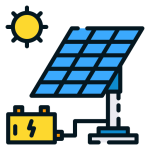
Facts and Fun-Facts about Energy and Energy Efficiency
- Home
- Facts and Fun-Facts about Energy and Energy Efficiency
Definitions and facts on energy

What is Energy
When a force is applied to an object to cause a displacement, that is called ‘work’. Energy refers to the ability to do any ‘work’. Although energy isn’t any material substance, it can be measured and stored in various ways. In fact, we don’t consume energy as energy is converted between different forms and thus works on different objects to allow our daily activities to go on.
Energy is important because it drives human life. For all human activities we need energy everywhere, every time, such as growing agricultural products, preparing food, heating, or cooling buildings. Whether we want to power a machine or want to just move our body, energy is behind all. You would not be able to move your finger if your body didn’t get chemical energy from food. As far as modern appliances or complex technologies like internet and computer applications are concerned, nothing can be operated without energy.

Why is Energy Important

How Does Energy Help Us?
Chemical energy allows our body to survive through the process of cellular respiration. Cellular respiration may either involve the chemical reaction of food molecules with molecular oxygen (aerobic respiration) or the process of reorganizing the food molecules without additional oxygen. Thermal energy is needed for preparing food, heating and cooling buildings, drying and manufacturing. “Electrical” energy is needed for lighting, heating, cooling, refrigerating, powering home appliances, computers, machinery, transports, and many other purposes.
Mechanical energy is needed for many manual tasks like lifting heavy objects, cutting tough materials, transporting things worldwide, and so on.
Energy efficiency is the use of less energy to provide the same or better products, services, or amenities. Increasing energy efficiency allows more control over energy use, lowers costs, and provides multiple benefits for households, businesses, and the environment. For example, changing the lights in your house from conventional bulbs to LED bulbs or applying efficient devices throughout your daily life helps to reduce the overall energy consumption and ultimately reduces your utility bills for electricity and cuts expenditures for other forms of energy like natural gas. Therefore, monetary and environmental benefits of energy efficiency are numerous. The long-term and national benefits will promote an overall decrease in electricity demand which will result in less investment in the generation and transmission of electricity.

Why Is Energy Efficiency Important?

How Does Electricity Affect Climate Change?
Around the world, about 40% of carbon dioxide is emitted from the generation of electricity using fossil fuels like petrol products or coal. Therefore, the more electricity is produced, the more carbon dioxide is released. Remember: filling a cylinder with natural gas also requires electricity for compressors and other devices. Fossil fuel-based electricity generation results in global warming and climate change. However, if electricity is generated from renewable resources like solar, wind, hydro or geothermal, these generation processes do not affect climate change.
FUN FACTS

Fun Facts Energy
Energy pipelines worldwide
There are more than 2 million miles of pipeline in this world for energy industries.
Food is also a form of energy.
While we normally mean electricity, gas, and power as energy, food is also a form of energy. Food is chemical energy that powers living organisms. When the body digests foods, which is basically biomass, it converts them into mechanical energy or heat.
Daylight saving time saves energy
Energy experts estimate that annual change from winter to summer times and vice versa, it results in saving 0.5 % of energy each day. Even though it’s an insignificant percentage, apparently it saves approx. 1.3 billion kWh of electricity that can power 100,000 households for a year.
Biomass is a great source of energy.
Biomass, such as organic waste or any type of wood or plant-based biomass, is a good source of renewable energy. It also can be used to generate electricity at any time irrespective of the daytime and weather conditions, e.g., compared to solar and wind energy.
Fossil fuels can run out in the future.
Fossil Fuels are being burnt to be converted into electricity at a higher rate than they’re being formed in nature. Environmental experts are anticipating that it can run out soon if it’s burnt at the same rate.
Oil is the largest source of primary energy.
Crude oil or petroleum is the most supplied primary energy source, especially for transportation. It’s also a basic element for petrochemicals like plastics. 4.5 billion metric tons of crude oil are being produced and supplied worldwide every year.

Fun Facts Electricity and Renewable Energy
Electricity generation: Approximately 40% of energy from all-natural resources is spent in the generation of electricity.
Speed of electricity: While electrical energy or electromagnetic waves travel at around 186,000 miles per second (speed of light), electricity in the wires and appliances in homes moves only about 1/100 of the speed of light (1,860 miles per second).
Electricity in human and animals:
– Human and animal bodies also use a form of electricity (bioelectricity) to transfer signals from cells to muscles.
– Electric eels can generate around 500 V (volts) of strong electric shocks for defence against predators and hunting their prey.
Electricity food by-products: In the French town of Albertville, a by-product (whey) of local Beaufort cheese is being used in a power plant to generate electricity. The whey of the cheese is used to produce biogas that fuels the power generation process. This cheese-based power plant is generating enough electricity that can power a community of 1,500 people. Such energetic use of by-products from agro-industry process is very common and includes, among others, the use of animal faeces, slaughterhouse waste, fruit and vegetable processing, used cooking oils as well as wastewater from breweries, distilleries, palm oil and sugar production.
Electricity consumption in the USA:
An average U.S. home needs annually 11,000 kWh (approx. 900 kWh monthly) of electricity.
Wind turbines:
A single wind turbine (with average monthly yield of 402,000 kWh) can power 460 homes for one month in the USA.
Internet searches:
People around the world perform around 40,000 searches every second on Google. Google’s data centres spend enough energy that can power 200,000 homes. It’s assumed that 10 Google searches cost energy that’s enough to power a 60-Watt lightbulb for an hour.
Coal:
In the USA, 20% of the total electricity is generated from coal. 60% of the total electricity is produced from fossil fuels.
Biogas: The faeces of one adult cow can generate around 0.35 kW all around the year, generating up to 3.000 kWh per year. With this amount of energy you can power your laptop for daily use or have 3-5 LED lightbulbs providing light 24/7!
Natural Gas and LNG :
The rotten smell is infused in the natural gas for detecting a gas leak.
In the primary state, natural gas is odourless. But a kind of “rotten egg” smell is infused in the natural gas by the manufacturer companies so that our nose can easily detect a gas leak.
Natural gasses are kept in liquid form while transporting
When natural gas is transported around the world, it’s kept in liquid form. Because in a liquid state it occupies less volume.
LNG is reduced by 600-fold before transporting
To convert the natural gas in a liquid state, it’s chilled to -161°C which increases the density by 600-fold.
There are 2.5 million miles of natural gas pipeline in the U.S.
The U.S. has over 2.5 million miles of pipeline for distributing natural gas. The UK alone has 171,000 miles of gas pipes, that can encircle the Earth more than four times.
Transportation of natural gas is sensitive
Methane is the main element of natural gas which is a greenhouse gas. Therefore, the transportation of natural gas is a very sensitive issue since undetected leaks can lead to climate change.

Fun Facts and Energy Efficiency
Incandescent and halogen lights are very inefficient
You’ll be surprised to know that these bulbs require only 10% of the total of the energy usage to light up a space. The rest of 90% of energy is spent to just produce (waste) heat.
LED bulbs are both efficient and durable
LED light bulbs use only around one-sixth of the electricity that the traditional incandescent bulbs use. But they are up to 40 times more long-lasting than the traditional ones.
Turning CFL lights on and off frequently can shorten their lifespans.
If you are using CFL bulbs or tubes, turning them on and off can shorten their lifespans. You should turn them off if you leave the room for 15 minutes or more. This is not the case for LED lightbulbs.
Conventional microwave ovens use more electricity to power the digital clock.
A conventional microwave oven uses more electricity to allow the digital clock to work continuously than heating your foods.
Electric appliances use energy even when they aren’t in use electric appliances use electricity even when they aren’t active but plugged in. An average-sized laptop consumes 20-60 W when switched-on and 5-10 W when being in sleeping-mode (screen turned off). A larger TV that is plugged-in, but turned-off can consume up to 10 W in the stand-by mode. Modern appliances are far more energy efficient.
An old fridge of 30 years uses about four times more electricity than a modern efficient one carrying an energy efficiency label.
Air conditioning in the USA consumes about 6% of all electricity generated in the country.
Almost 75% of US homes have air conditioners installed. According to the U.S Department of Energy, air conditioner usage amounts to about 6% of total electricity produced in the country. Converting this usage into monetary terms gives a staggering amount of USD 29 billion.

Fun Facts on Solar Energy
- Harnessing solar energy from our sun for 60 minutes could cover the total energy demand of the entire Earth for one year.
The sun supplies approx. 430 quintillion Joules of energy per hour to the Earth. If we could harness just one hour’s energy from the sun, it alone can power the Earth for the whole year. - Solar energy can be the primary source of power in future.
As we’re supposed to run out of fossil fuels in future, the solar energy can be the primary source of power by 2040. - A single lightning bolt releases five times more heat than the sun. When bolts from lightning are released into the atmosphere, they heat the air five times hotter than the sun does, up to 30,000°C.
.
